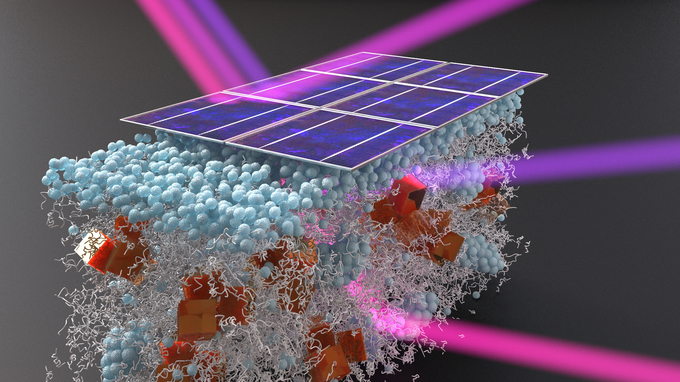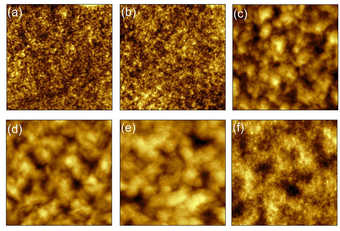Warum Solarzellen mit Zusatzstoffen effizienter sind
2018-11-15 – Nachrichten aus dem Physik-Department

Eine Solarzelle wandelt Sonnenenergie in Strom um. Trifft Sonnenlicht auf die Zelle, werden positive und negative Ladungsträger freigesetzt, die an den beiden Elektroden gesammelt werden und den Strom ergeben. Zwischen den Elektroden befindet sich die sogenannte aktive Schicht aus halbleitenden Material, das im Fall der organischen Solarzellen aus Polymeren besteht. Dabei werden zwei Arten von Polymeren, nämlich Elektronendonatoren, die die Elektronen abgeben, und Elektronenakzeptoren, die die Elektronen aufnehmen, benötigt. Die Grenzfläche zwischen den Akzeptor- und Donormaterialien, ist entscheidend für die Effizienz der Solarzellen.
Organische Solarzellen haben bislang eine Effizienz von bis zu 13% bei der Umwandlung von Solarenergie in elektrische Energie erreicht. Das mag zunächst im Vergleich zu den hochoptimierten, anorganischen Photovoltaikanlagen (bis zu 43%) klein erscheinen. Man muss jedoch dabei berücksichtigen, dass die Plastiksolarzellen ein noch recht junges Forschungsgebiet sind.
Wissenschaftler des Lehrstuhls für Funktionelle Materialien am Physik-Department der TUM forschen seit einigen Jahren an organischen Photovoltaikzellen. Weil Neutronen Informationen aus dem Inneren der dünnen Schichten liefern können, nutzen sie die Messmöglichkeiten am MLZ. Die Gruppe um Prof. Dr. Peter Müller-Buschbaum möchte vor allem die Frage lösen, warum einige lösliche Zusatzstoffe, wie zum Beispiel das 1,8-Oktanedithiol (ODT), in der aktiven Schicht die Leistung der Plastiksolarzellen erhöhen. „Nur wenige Prozent dieses Zusatzstoffes können die Effizienz schon dramatisch erhöhen“, sagt Dr. Lin Song, Post-Doktorand am Lehrstuhl für Funktionelle Materialien. Bislang hatten Wissenschaftler immer nur Oberflächenstrukturen mit Mikroskopie untersucht. Es wurde jedoch bereits beobachtet, dass die Oberflächenstruktur und die innere Struktur sehr unterschiedlich aufgebaut sind.

Neutronen sind nun das Mittel der Wahl, um tiefer in die mysteriöse innere Morphologie hineinzusehen und herauszufinden, wie der Zusatzstoff die Struktur verändert. Dr. Weijia Wang und Dr. Lin Song untersuchten ihre Proben an dem Neutronenreflektometer REFSANS am MLZ. Sie gaben verschiedene Konzentrationen des Zusatzstoffes ODT hinzu. Instrumentwissenschaftler Dr. Jean-Francois Moulin vom Helmholtz-Zentrum Geesthacht wandte dabei die sogenannte Kleinwinkelstreuung unter streifendem Einfall (englisch GISANS) an. „Kombiniert mit der Flugzeitmethode (TOF) am REFSANS haben wir komplett neue Einblicke in die innere Struktur und in die Oberflächenbeschaffenheit erhalten“, sagt Lin Song.
Die Ergebnisse zeigen, dass die Oberfläche und das Innere der Zwischenschicht ohne Zusatzstoff ähnlich sind. Außerdem hatten sich vereinzelte Nano-Inseln geformt. „Die Ladungsträger werden in diesen Inseln gefangen“, erklärt Lin Song. Hingegen ist die Struktur mit dem Zusatzstoff ODT ganz anders aufgebaut: Es gibt weniger Fallen für die Ladungsträger, die Zwischenverbindungen sind besser entwickelt und folglich können die Ladungsträger viel besser transportiert werden.
Es gibt jedoch ein Limit, jenseits dessen ein Mehr an Zusatzstoff die Effizienz nicht mehr weiter steigert. Die Neutronen konnten dies auch zeigen: Wenn die Konzentration des Zusatzstoffes zu hoch ist, formt das ODT eine kompakte Schicht von Akzeptoren auf der Oberfläche. Jetzt unterscheiden sich Oberfläche und innere Struktur. „Wir haben jetzt zum ersten Mal aus molekularer Sicht erklärt, warum die Effizienz nicht mehr weiter gesteigert werden kann“, sagt Weijia Wang. Rasterkraftmikroskopische Untersuchungen und Röntgenmessungen unterstützen diese Ergebnisse.
Veröffentlichung
Verwandte Meldungen
- Schalten mit Molekülen – 2018-05-24
- Peter Müller-Buschbaum folgt auf Winfried Petry – 2018-03-29
- Röntgenblick zeigt Verschleiß von Polymersolarzellen – 2016-10-24
- Maßgeschneiderte organische Elektronik aus dem Drucker – 2015-06-17